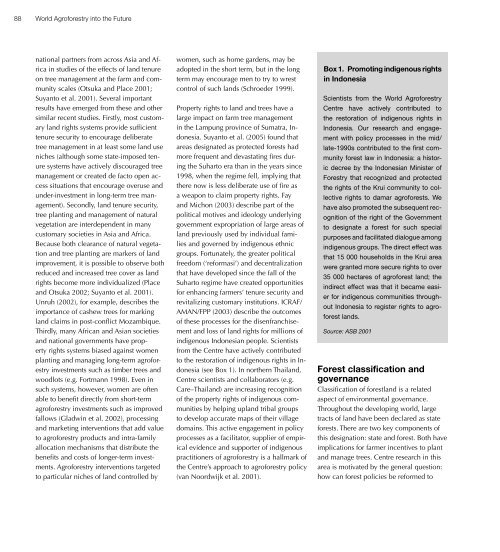The challenge of HIV/AIDS: Where does agroforestry fit in? - World ...
The challenge of HIV/AIDS: Where does agroforestry fit in? - World ...
The challenge of HIV/AIDS: Where does agroforestry fit in? - World ...
Create successful ePaper yourself
Turn your PDF publications into a flip-book with our unique Google optimized e-Paper software.
88<strong>World</strong> Agr<strong>of</strong>orestry <strong>in</strong>to the Futurenational partners from across Asia and Africa<strong>in</strong> studies <strong>of</strong> the effects <strong>of</strong> land tenureon tree management at the farm and communityscales (Otsuka and Place 2001;Suyanto et al. 2001). Several importantresults have emerged from these and othersimilar recent studies. Firstly, most customaryland rights systems provide sufficienttenure security to encourage deliberatetree management <strong>in</strong> at least some land useniches (although some state-imposed tenuresystems have actively discouraged treemanagement or created de facto open accesssituations that encourage overuse andunder-<strong>in</strong>vestment <strong>in</strong> long-term tree management).Secondly, land tenure security,tree plant<strong>in</strong>g and management <strong>of</strong> naturalvegetation are <strong>in</strong>terdependent <strong>in</strong> manycustomary societies <strong>in</strong> Asia and Africa.Because both clearance <strong>of</strong> natural vegetationand tree plant<strong>in</strong>g are markers <strong>of</strong> landimprovement, it is possible to observe bothreduced and <strong>in</strong>creased tree cover as landrights become more <strong>in</strong>dividualized (Placeand Otsuka 2002; Suyanto et al. 2001).Unruh (2002), for example, describes theimportance <strong>of</strong> cashew trees for mark<strong>in</strong>gland claims <strong>in</strong> post-conflict Mozambique.Thirdly, many African and Asian societiesand national governments have propertyrights systems biased aga<strong>in</strong>st womenplant<strong>in</strong>g and manag<strong>in</strong>g long-term agr<strong>of</strong>orestry<strong>in</strong>vestments such as timber trees andwoodlots (e.g. Fortmann 1998). Even <strong>in</strong>such systems, however, women are <strong>of</strong>tenable to bene<strong>fit</strong> directly from short-termagr<strong>of</strong>orestry <strong>in</strong>vestments such as improvedfallows (Gladw<strong>in</strong> et al. 2002), process<strong>in</strong>gand market<strong>in</strong>g <strong>in</strong>terventions that add valueto agr<strong>of</strong>orestry products and <strong>in</strong>tra-familyallocation mechanisms that distribute thebene<strong>fit</strong>s and costs <strong>of</strong> longer-term <strong>in</strong>vestments.Agr<strong>of</strong>orestry <strong>in</strong>terventions targetedto particular niches <strong>of</strong> land controlled bywomen, such as home gardens, may beadopted <strong>in</strong> the short term, but <strong>in</strong> the longterm may encourage men to try to wrestcontrol <strong>of</strong> such lands (Schroeder 1999).Property rights to land and trees have alarge impact on farm tree management<strong>in</strong> the Lampung prov<strong>in</strong>ce <strong>of</strong> Sumatra, Indonesia.Suyanto et al. (2005) found thatareas designated as protected forests hadmore frequent and devastat<strong>in</strong>g fires dur<strong>in</strong>gthe Suharto era than <strong>in</strong> the years s<strong>in</strong>ce1998, when the regime fell, imply<strong>in</strong>g thatthere now is less deliberate use <strong>of</strong> fire asa weapon to claim property rights. Fayand Michon (2003) describe part <strong>of</strong> thepolitical motives and ideology underly<strong>in</strong>ggovernment expropriation <strong>of</strong> large areas <strong>of</strong>land previously used by <strong>in</strong>dividual familiesand governed by <strong>in</strong>digenous ethnicgroups. Fortunately, the greater politicalfreedom (‘reformasi’) and decentralizationthat have developed s<strong>in</strong>ce the fall <strong>of</strong> theSuharto regime have created opportunitiesfor enhanc<strong>in</strong>g farmers’ tenure security andrevitaliz<strong>in</strong>g customary <strong>in</strong>stitutions. ICRAF/AMAN/FPP (2003) describe the outcomes<strong>of</strong> these processes for the disenfranchisementand loss <strong>of</strong> land rights for millions <strong>of</strong><strong>in</strong>digenous Indonesian people. Scientistsfrom the Centre have actively contributedto the restoration <strong>of</strong> <strong>in</strong>digenous rights <strong>in</strong> Indonesia(see Box 1). In northern Thailand,Centre scientists and collaborators (e.g.Care–Thailand) are <strong>in</strong>creas<strong>in</strong>g recognition<strong>of</strong> the property rights <strong>of</strong> <strong>in</strong>digenous communitiesby help<strong>in</strong>g upland tribal groupsto develop accurate maps <strong>of</strong> their villagedoma<strong>in</strong>s. This active engagement <strong>in</strong> policyprocesses as a facilitator, supplier <strong>of</strong> empiricalevidence and supporter <strong>of</strong> <strong>in</strong>digenouspractitioners <strong>of</strong> agr<strong>of</strong>orestry is a hallmark <strong>of</strong>the Centre’s approach to agr<strong>of</strong>orestry policy(van Noordwijk et al. 2001).Box 1. Promot<strong>in</strong>g <strong>in</strong>digenous rights<strong>in</strong> IndonesiaScientists from the <strong>World</strong> Agr<strong>of</strong>orestryCentre have actively contributed tothe restoration <strong>of</strong> <strong>in</strong>digenous rights <strong>in</strong>Indonesia. Our research and engagementwith policy processes <strong>in</strong> the mid/late-1990s contributed to the first communityforest law <strong>in</strong> Indonesia: a historicdecree by the Indonesian M<strong>in</strong>ister <strong>of</strong>Forestry that recognized and protectedthe rights <strong>of</strong> the Krui community to collectiverights to damar agr<strong>of</strong>orests. Wehave also promoted the subsequent recognition<strong>of</strong> the right <strong>of</strong> the Governmentto designate a forest for such specialpurposes and facilitated dialogue among<strong>in</strong>digenous groups. <strong>The</strong> direct effect wasthat 15 000 households <strong>in</strong> the Krui areawere granted more secure rights to over35 000 hectares <strong>of</strong> agr<strong>of</strong>orest land; the<strong>in</strong>direct effect was that it became easierfor <strong>in</strong>digenous communities throughoutIndonesia to register rights to agr<strong>of</strong>orestlands.Source: ASB 2001Forest classification andgovernanceClassification <strong>of</strong> forestland is a relatedaspect <strong>of</strong> environmental governance.Throughout the develop<strong>in</strong>g world, largetracts <strong>of</strong> land have been declared as stateforests. <strong>The</strong>re are two key components <strong>of</strong>this designation: state and forest. Both haveimplications for farmer <strong>in</strong>centives to plantand manage trees. Centre research <strong>in</strong> thisarea is motivated by the general question:how can forest policies be reformed to




![MNC_00_Modau [Compatibility Mode].pdf](https://img.yumpu.com/51432208/1/190x146/mnc-00-modau-compatibility-modepdf.jpg?quality=85)











